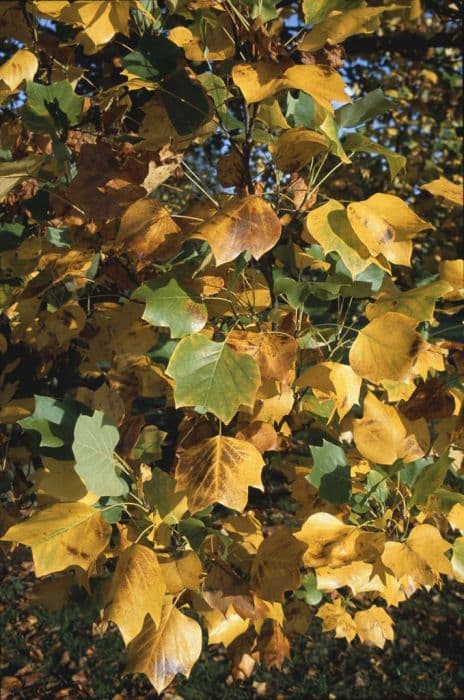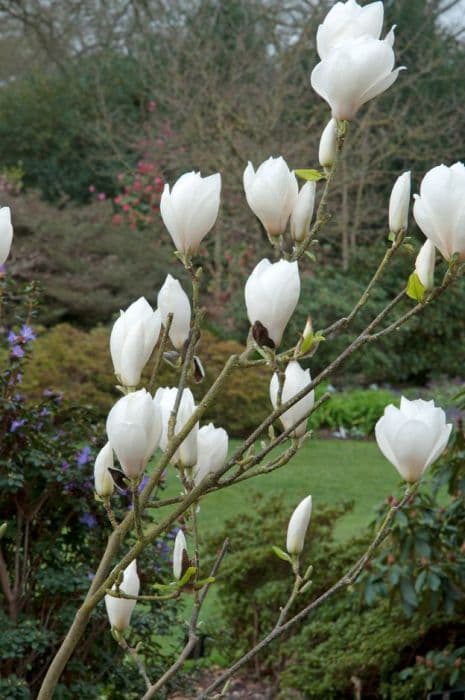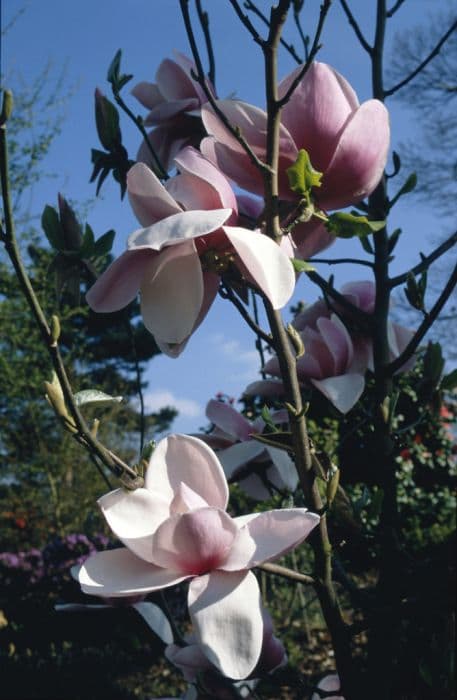Darjeeling Magnolia Magnolia campbellii 'Darjeeling'

ABOUT
The Magnolia 'Darjeeling' is a captivating plant known for its spectacular floral display. It boasts large, cup-shaped flowers that typically emerge in shades of deep pink at the base, gracefully transitioning to a softer pink or even white at the tips. These flowers create a dramatic display with their size, often spanning several inches across, and grow on the ends of its sturdy branches, making them quite prominent. The blooming is especially prolific in the early spring months, sometimes before the leaves fully unfurl. The leaves of this magnolia are themselves quite impressive - broad, dark green, and glossy, with a leathery texture. They form a lush backdrop for the flowers and continue to provide an attractive canopy throughout the growing season. After the initial flowering period, the plant may produce cone-like fruit that add an additional point of interest in the landscape. These fruits contain seeds that are favored by local wildlife. The overall form of 'Darjeeling' magnolia is quite pleasing, with a branching pattern that gives the plant a robust and balanced appearance. Its spreading branches create a semi-rounded silhouette that is particularly elegant in a garden setting. It's also worth noting that the exquisite blossoms of the 'Darjeeling' magnolia often emit a delightful fragrance, which adds another sensory dimension to its already striking presence.
About this plant
 Names
NamesFamily
Magnoliaceae.
Synonyms
Darjeeling Magnolia, Himalayan Magnolia.
Common names
Magnolia campbellii 'Darjeeling'.
 Toxicity
ToxicityTo humans
Magnolia campbellii, commonly known as the Pink Tulip Tree, is not considered toxic to humans. Generally, magnolias are viewed as non-poisonous plants, and there are no well-documented cases of poisoning from ingestion of any parts of the plant. However, as with any non-food plant, individual sensitivities can vary and it's possible that someone might experience an adverse reaction if they were to ingest parts of the plant, such as a mild stomach upset. It is always advisable to err on the side of caution and not consume plant material that is not known to be safe for consumption.
To pets
Magnolia campbellii, more commonly called the Pink Tulip Tree, is also not considered toxic to pets. It is not listed on common toxic plant databases for animals such as dogs and cats. Ingestion of plant parts, including the leaves or blooms, is unlikely to lead to poisoning or serious consequences. However, individual pets may exhibit different levels of sensitivity and could experience mild gastrointestinal upset if they consume parts of the plant. It's always a good practice for pet owners to prevent their pets from eating ornamental plants, as non-food plants can sometimes cause irritation or gastrointestinal discomfort even if they are not toxic.
 Characteristics
CharacteristicsLife cycle
Perennials
Foliage type
Deciduous
Color of leaves
Green
Flower color
Pink
Height
20-30 feet (6-9 meters)
Spread
20 feet (6 meters)
Plant type
Tree
Hardiness zones
7
Native area
Himalayas
Benefits
 General Benefits
General Benefits- Aesthetic Appeal: Adds vibrant color and visual interest to landscapes with its large, showy flowers.
- Year-Round Interest: Deciduous nature offers seasonal changes, with stunning blooms in early spring and attractive foliage through summer and fall.
- Habitat for Wildlife: Provides nectar for pollinators, including bees and butterflies, during its blooming season.
- Shade Provider: Once mature, its broad canopy offers shade, which can help in reducing energy costs by cooling nearby structures.
- Ornamental Use: Popular in gardens and landscapes for its ornamental value, often used as a focal point or specimen plant.
- Cultural Significance: Often associated with nobility and dignity, and can carry cultural or historical significance in certain regions.
- Low Maintenance: Typically requires minimal pruning and is relatively easy to care for once established in the right conditions.
 Medical Properties
Medical PropertiesThis plant is not used for medical purposes.
 Air-purifying Qualities
Air-purifying QualitiesThis plant is not specifically known for air purifying qualities.
 Other Uses
Other Uses- The bark of the Magnolia campbellii can be used in tanning leather, providing an organic alternative to chemical tannins.
- Wood from the tree is sometimes used in fine woodworking for its attractive appearance and workability.
- Artists may use the petals and blossoms for botanical illustration due to their large size and striking color.
- This tree's unique seed pods can be dried and used in floral arrangements or as a natural decor element.
- The magnolia's leaves can be used for creating natural dyes, with the possibility of yielding subtle green or brown hues.
- In certain cultures, parts of the tree, like branches or bark, could be incorporated into religious or spiritual ceremonies.
- The scent of Magnolia campbellii flowers can be captured in perfumery, though it's not commonly commercially produced.
- Landscape artists use the tree as a focal point in garden design, due to its noteworthy blossoms and striking form.
- Photographers often seek out this species for its photogenic qualities, especially during the blooming season.
- Carpenters may use the timber from the Magnolia campbellii for crafting musical instruments like guitars or violins for its acoustic properties.
Interesting Facts
 Feng Shui
Feng ShuiThe Magnolia is not used in Feng Shui practice.
 Zodiac Sign Compitability
Zodiac Sign CompitabilityThe Magnolia is not used in astrology practice.
 Plant Symbolism
Plant Symbolism- Perseverance and Endurance: Magnolia campbellii, commonly known as Himalayan magnolia, often blooms early in the spring, sometimes even before the snow has melted, symbolizing the ability to endure and thrive even in difficult conditions.
- Nobility and Dignity: Due to their impressive appearance and stature, Himalayan magnolias are frequently associated with nobility and dignity, reflecting the graceful and majestic nature of someone who bears themselves with a natural elegance.
- Feminine Beauty: Magnolias are often connected with feminine beauty and softness, stemming from their delicate and showy flowers that are traditionally seen as a representation of purity and gentleness.
- Purity and Innocence: The pure white flowers of some magnolias, including certain Himalayan magnolia varieties, are symbols of purity and innocence, echoing the unblemished quality of the flower and often used in contexts to suggest a fresh start or new beginnings.
- Love of Nature: Given their role in the ecosystem and the joy they bring to those who observe them, Himalayan magnolias are viewed as an emblem of an individual's love for nature and the outdoors.
 Water
WaterThe Darjeeling Magnolia should be watered deeply to ensure the soil is moist but not waterlogged, usually requiring about 1.5 gallons for young trees spread over a week and more for established trees depending on the weather and soil conditions. Watering frequency should be adjusted according to the season, with more regular watering in the growing season (spring and summer) usually every week, and reduced in the dormant season (fall and winter) to every two weeks or less. The preferred method is to water at the base of the plant, avoiding overhead watering to prevent leaf diseases. Always check the top few inches of soil for dryness before watering again.
 Light
LightThe Darjeeling Magnolia thrives best in full sun to partial shade. It should be planted in a location where it can receive at least 4 to 6 hours of direct sunlight each day. However, in hotter climates, providing some afternoon shade will help protect the tree from excessive heat.
 Temperature
TemperatureThe Darjeeling Magnolia prefers a temperate climate with ideal temperature conditions ranging between 60°F to 80°F. It can tolerate minimum temperatures down to about 20°F. Extreme heat above 90°F or cold below 20°F can be harmful to the tree, and it should be protected from harsh conditions.
 Pruning
PruningPruning of the Darjeeling Magnolia is done to maintain shape, remove dead or damaged branches, and promote healthy growth. The best time to prune is in late winter or early spring before the new growth starts. It should be pruned sparingly, removing only what is necessary, as magnolias do not recover well from heavy pruning.
 Cleaning
CleaningAs needed
 Soil
SoilThe ideal soil mix for Darjeeling Magnolia should be rich, well-draining, and slightly acidic to neutral with a pH of 5.5 to 7.0. A combination of loamy soil, peat, compost, and a bit of sand for improved drainage is recommended to provide the necessary nutrients and moisture retention.
 Repotting
RepottingDarjeeling Magnolias are typically planted in the ground and do not require frequent repotting. However, if grown in a container, they should be repotted every 3-5 years to ensure sufficient space for root growth and soil nutrient replenishment.
 Humidity & Misting
Humidity & MistingDarjeeling Magnolia flourishes in moderate to high humidity levels; however, it is adaptable and can tolerate lower humidity if necessary. Outdoor plants are usually well adapted to local conditions, while indoor plants may benefit from a pebble tray or humidifier.
 Suitable locations
Suitable locationsIndoor
Ensure bright, indirect light and space for growth.
Outdoor
Plant in well-drained, acidic soil; full sun to partial shade.
Hardiness zone
7-9 USDA
 Life cycle
Life cycleMagnolia campbellii 'Darjeeling', commonly known as Darjeeling magnolia, starts its life cycle as a seed, typically germinating in moist, well-drained soil in a shaded environment. During the seedling stage, the plant slowly establishes a root system and a stem with cotyledons (seed leaves), then develops its first true leaves. As it enters the juvenile stage, it continues to grow in height and girth, producing more complex leaf patterns and begins initial branching, although it may take several years before it reaches maturity and is ready to flower. Once mature, the Darjeeling magnolia enters its reproductive phase, typically characterized by the production of large, showy flowers that are pinkish to white in color, attracting pollinators and leading to fertilization. After pollination, the flowers give way to cone-like fruit aggregates that release individual red or orange seeds, which are often dispersed by birds and mammals. Finally, after a long productive period, which could last for decades or even more than a century, the tree enters its senescence phase, characterized by a decline in growth and reproductive capacity until it eventually dies.
 Propogation
PropogationPropogation time
Late winter-early spring
The most common method for propagating Magnolia campbellii 'Darjeeling', often referred to as Darjeeling Magnolia, is by seed. The best time for sowing seeds is in the fall, just after collection, to allow for the natural stratification process over the winter. To propagate by seed, collect ripe seed cones from the tree and extract the seeds from the red pulp. Clean the seeds thoroughly and sow them in a well-drained seed-starting mix, covering lightly with soil. The seeds require a cold period to break dormancy, so if not sown immediately, they should be mixed with moist sand and stored in the refrigerator (3-5 degrees Celsius or 37-41 degrees Fahrenheit) for at least 3 months before planting. Seedlings can take anywhere from 6 months to a year to germinate, and it may be several years before they bloom.









